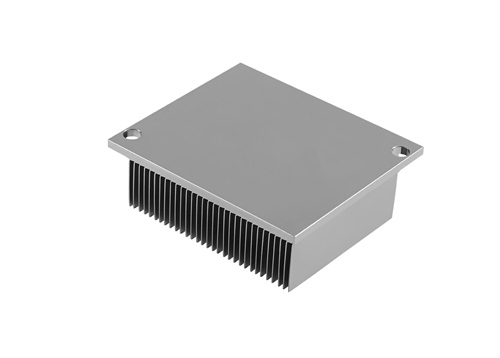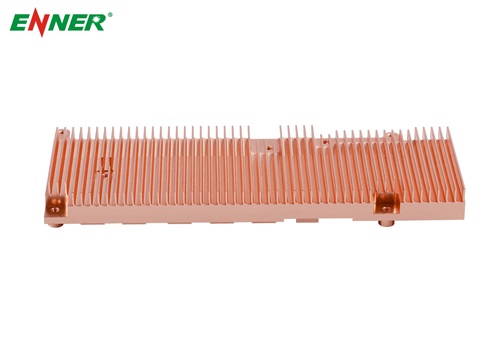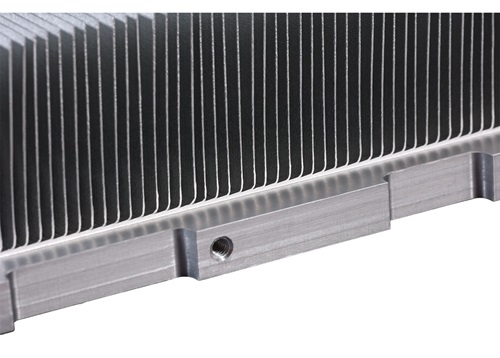Skived heat sinks have earned a trusted place in thermal design—not because they promise breakthroughs, but because they consistently deliver where it counts. From their seamless construction to their adaptability in tight spaces, they solve thermal demands without complicating the rest of the system. Here are five clear reasons why engineers across industries continue to choose them when performance, reliability, and design flexibility matter most.
The skiving process doesn't involve assembly. It doesn't need adhesive, solder, or welds. A blade carves out fins directly from a single block of copper or aluminum, pulling them upward without breaking continuity. There's no boundary between the base and the fins—just uninterrupted metal.
This matters more than it sounds. In many systems, thermal performance is determined not by surface area alone, but by what stands in the way. Adhesive layers introduce variability. Mechanical joins loosen. Bonding paste becomes brittle under thermal cycling. Skived sinks sidestep all of it.
Consider a power conversion module operating inside a sealed metal enclosure. Airflow is minimal. The only escape route for heat is through the heat sink and into the ambient casing. In this scenario, even small interface resistances compound. With a skived sink, the path from the device surface to the air is short, clean, and uninterrupted.
That single-piece construction also resists fatigue. Systems exposed to shock, vibration, or repeated heating and cooling cycles benefit from having fewer failure points. There's nothing to delaminate, no interface to separate, and no loosening of fin arrays over time. That reliability isn't theoretical. It's measurable in accelerated life testing, and it shows in the lower maintenance schedules of systems that rely on this structure.

Design teams don't always start with freedom. More often, they're working backward from enclosure sizes, regulatory limits, airflow constraints, or legacy hardware they can't replace. Heat sinks, in these cases, aren't added to an ideal layout—they're squeezed into what's left.
Skived heat sinks offer freedom precisely because they don't require molds. An extruded or cast component is locked to a die. Want thinner fins? New tooling. Need a broader base? Start over. With skiving, parameters can be adjusted through programming alone—fin pitch, height, thickness, shape.
This becomes a distinct advantage during late-stage development. Let's say a new power supply revision runs hotter than expected. The internal space hasn't changed, but the thermal output has. Instead of reworking the housing or changing the board layout, engineers can iterate the heat sink itself—taller fins, tighter spacing, or a deeper base for better thermal absorption—all without waiting for new tooling.
This agility is not just helpful in emergencies. It's valuable when exploring design variants, running thermal simulations with multiple profiles, or optimizing products for performance tiers. And in custom builds or low-to-mid volume runs, avoiding tooling altogether slashes lead times and production risk.
Material selection often comes down to trade-offs. Copper moves heat faster—roughly twice the conductivity of aluminum—but it's heavier, more expensive, and harder to machine. Aluminum is lighter, cheaper, easier to shape, and often "good enough" in systems where forced airflow or design headroom compensates for lower conductivity.
Skived heat sinks don't force a choice between process compatibility and material needs. The same cutting method applies to both metals. This allows designers to prioritize what matters most:
There's also the matter of mounting and integration. Copper's weight isn't always acceptable on vertically mounted boards or in mobile devices. But for rack-mounted systems or grounded industrial panels, it's not a concern. Skiving accommodates either direction—without changing the process, which makes logistics easier and inventory leaner.
Hybrid systems are another case. In some devices, copper skived sinks are used directly on hotspot components, while surrounding regions rely on aluminum units. Shared geometry, consistent finish, and matched thermal resistance across zones—it's easier to coordinate all that when the heat sinks share a process.

Engineers rarely say, “We have too much room for thermal components.” Especially in compact builds, the mechanical envelope left for cooling hardware is thin—sometimes literally. Tall extrusions don't fit. Forced airflow can't be guaranteed. And off-the-shelf sinks are just too wide, too short, or not efficient enough.
What skived fins offer is surface area where there appears to be none. Because the fins are cut with precision, they can be spaced tighter and made thinner than extruded alternatives. That increases convection area dramatically, even when the sink profile stays flat. High aspect ratios, up to 30:1 in some cases, mean that thermal mass can be stacked vertically—without increasing overall dimensions.
There's also the benefit of shaping airflow. In enclosed boxes with directional venting, airflow doesn't travel randomly—it follows channels, corners, ducts. Fins can be aligned with that movement to reduce turbulence and allow cleaner convection. Skiving makes this possible in a way extrusion doesn't. There's no need to orient a mold—just reprogram the cutting path.
In field applications like solar inverters, outdoor telecom nodes, or onboard vehicle controllers, this space-to-performance ratio makes a difference. Passive systems can't afford to waste millimeters. And in those scenarios, performance isn't just about keeping cool—it's about staying within thermal budget long enough to pass inspection, secure certification, or deliver warranty coverage.
Heat sinks often go unexamined during maintenance—until they fail. But they can fail in subtle ways: fins bend, loosen, or detach; joints crack under vibration; adhesives harden and lose contact. In rugged installations or environments with constant mechanical stress, these risks aren't rare.
Skived sinks are different by construction. Because they're made from one piece of metal, they don't separate. Fins don't shake loose, don't twist off axis, don't shift from repeated expansion and contraction. In systems that move—trains, turbines, off-road machinery—that matters.
Take a skived heat sink mounted on a control board inside a shipping crane. That board sees hours of vibration, hard stops, and weather changes. A traditional bonded-fin sink might survive the first year, but by year three, maintenance logs show instability. Slightly worse thermal resistance. A hairline crack. Dust gathering where fins separated.
With a skived unit, the fin structure is stable from day one. There's nothing to delaminate, nothing to check with a torque wrench. What's installed stays installed. And when you're managing hundreds of remote units, fewer inspections matter.
This mechanical reliability also affects acoustics. In fanless systems, loose parts cause rattle. In enclosed panels, shifting fins reflect EM noise differently. The benefits of structural simplicity go beyond heat—they affect the whole system behavior.

Skived heat sinks don't shout for attention, but their results speak clearly. They cool more efficiently because they remove layers that get in the way. They adapt faster because they don't require molds. They survive longer because they don't fall apart. Whether the system is built for silence, sealed for protection, or running near its thermal limit, these sinks give engineers one less thing to worry about. For copper or aluminum skived heat sinks tailored to real-world constraints, Enner delivers w...
Contact us
[email protected] https://www.ennergroup.com/By continuing to use the site you agree to our privacy policy Terms and Conditions.